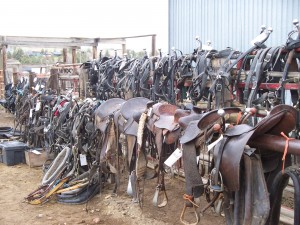 …or lessons in what not to do if you don’t want to lose your shirt. No waving. Don’t arrange your hair. Try not to scratch your nose. Otherwise, you could become the owner of a lovely chuckwagon or a full set of brass-fitted show harnesses. Not that I would mind having something like that, but the wallet would be screaming. (Not to mention the trouble I’d have getting it home. Me, with my little econo-car…) I did buy a lovely set of hip-drop bells that I adore. I believe they will be staying in the house, adorning my walls, however, rather than hanging out in the tack room.
…or lessons in what not to do if you don’t want to lose your shirt. No waving. Don’t arrange your hair. Try not to scratch your nose. Otherwise, you could become the owner of a lovely chuckwagon or a full set of brass-fitted show harnesses. Not that I would mind having something like that, but the wallet would be screaming. (Not to mention the trouble I’d have getting it home. Me, with my little econo-car…) I did buy a lovely set of hip-drop bells that I adore. I believe they will be staying in the house, adorning my walls, however, rather than hanging out in the tack room.
One event I really enjoyed was the Washington Young Farmers Coalition roundtable discussion. Sixty-five people showed up for it, which was many more than was expected. The room was full of folks. I jotted down some of the questions and answers as far as I could. Here are some of the questions posed along with some potential ideas for answers:
- What can we do to effect national legislation concerning farming? Monitor the farm bill and the two micro bills currently going through congress. Contact your congressional representatives and let them know your opinion.
- How can we integrate other businesses on the farm? Choose complimentary businesses or ones that you might be able to do in the off season, such as tree-trimming, metal fabrication, farrier services, farming-related classes, distribution services, etc.
- How can young farmers acquire land and deal with debt, especially student loans? That’s a good question…
- Can farms be run as non-profits? Sure, just provide goods and services for underserved customers. Teaching self-sustainability classes or growing crops for low-income customers both would work.
- What’s the best way to interject energy into the local granges? Get involved in the local community. Get to know the other farmers around you.
There were lots of other suggestions, as well:
- Fight legislation that impedes your ability to farm.
- Start seed swapping events with other farmers and market gardeners.
- Engage older farmers in an inter-generational network. It’s great to learn from experienced folks and farmers love to talk about growing things.
- Get involved in farmland preservation.
- Combine resources across farms.
- Crop mobs! They are great to have on your farm or to participate in one.
- Look into IDA savings plans as a way to save for farms.
People brought up lots of others subjects as well, but my brain was so full of farming goodness by the end of the roundtable, I just couldn’t add anymore.
It was so great to be in a room full of such enthusiasm. I was impressed by the level of intelligence and knowledge of the participants and felt that, even with all the pressing issues farmers have to confront, the future of farming is in good hands.
